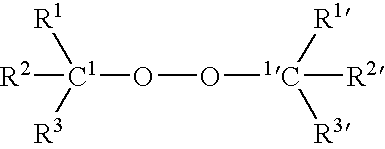Modified Polymer Compositions, Modification Process and Free Radical Generating Agents
a technology of polymer compositions and free radicals, applied in the direction of coatings, conductors, electrical equipment, etc., can solve the problems of flammability, explosive and volatile methane, and the risk of the cable manufacturing process, and achieve excellent properties, high quality, and superior properties.
- Summary
- Abstract
- Description
- Claims
- Application Information
AI Technical Summary
Benefits of technology
Problems solved by technology
Method used
Image
Examples
example 1
Preparation of Di-(1-methyl-1-phenylundecyl) peroxide
(R1, R1′=Phenyl; R2, R2′=Methyl; R3, R3′=Decyl)
[0281]
[0282]A. 1-methyl-1-phenylundecyl alcohol
[0283]To a suspension of 2.43 g (0.1 mol) magnesium turnings in 10 ml of diethyl ether was added 0.1 ml of 1,2-dibromoethane and the mixture was stirred. 22.17 g (0.1 mol) of 1-bromodecane in 20 ml diethyl ether was added dropwise and the mixture was refluxed for 15 minutes, then cooled. 9.61 g (0.08 mol) of acetophenone in 20 ml diethyl ether was added while cooling on ice bath. The ice bath was removed and the reaction mixture stirred at room temperature for 30 minutes. The mixture was then poured into a slurry of 30 g ammonium chloride in 150 ml water and 100 g ice while stirring vigorously. The mixture was filtered, the ether layer separated and the aqueous layer extracted twice with 50 ml of ether. The organic layers were combined, washed with water, 10% NaHSO3, brine, dried and evaporated to give 22.48 g of clear oil. The oil was pu...
example 2
Preparation of Di(1-methyl-cyclohexyl) peroxide
[0288](R1=Methyl; R2+R3 Form Together with C1 a Cyclohexyl Ring and R1′=Methyl; R2′+R3′ Form Together with C1′ a Cyclohexyl Ring)
[0289]A. Di(1-Methyl-Cyclohexyl)Peroxide
[0290]1-methylcyclohexanol (30 g, 0.26 mol) was placed in a 100 mL three necked round bottomed flask and was stirred. Inc flask was cooled in a brine / ice bath, dropping funnel fitted and fitted with a static N2 supply. The dropping funnel was charged with 98% sulfuric acid (16.14 ml) and water (6.45 ml) giving a 70% sulfuric acid solution. This was added dropwise to the 1-methylcyclohexanol and stirring continued to give a viscous brown mixture. The bath was recharged with ice / brine, dropping funnel rinsed with water and recharged with 35% hydrogen peroxide (6.98 mL, 0.125 mol) and added dropwise. The solution separated into two phases. Cyclohexanol (150 mL) was added and the mixture was transferred to a separating funnel. The aqueous fraction was extracted with another ...
example 3
Preparation of Di(1-methyl-cyclopentyl) peroxide
[0291](R1=Methyl; R2+R3 Form Together with C1 a Cyclopentyl Ring and R1′=Methyl; R2′+R3′ Form Together with C1′ a Cyclopentyl Ring)
[0292]A. Di(1-methyl-cyclopentyl) peroxide
[0293]A 250 ml tri-neck round bottom flask was equipped and a 50 ml addition funnel and the flask was cooled 2SO4 solution was prepared and cooled in an ice bath. The H2SO4 (12.71 ml, 0.91 M, 3 EQ) was added drop wise over 15 minutes and the reaction mixture was stirred for ˜2.5 hours in order to allow all the 1-methylcyclopentanol to dissolve. With the reaction stirring, 8.11 ml of H2O2 35% (wt) (0.24 M, 0.8 EQ) was added drop wise over 15 minutes. The reaction was left stirring overnight. The reaction mixture was transferred to a separation funnel and extracted three times with 50 ml of pentane each time. Organic layers were collected and the aqueous was set aside. The organic layers were extracted 3 times with 50 ml of 1N NaOH each time to remove excess acid. The...
PUM
| Property | Measurement | Unit |
|---|---|---|
| diameter | aaaaa | aaaaa |
| elevated temperature | aaaaa | aaaaa |
| elevated temperature | aaaaa | aaaaa |
Abstract
Description
Claims
Application Information
 Login to View More
Login to View More - R&D
- Intellectual Property
- Life Sciences
- Materials
- Tech Scout
- Unparalleled Data Quality
- Higher Quality Content
- 60% Fewer Hallucinations
Browse by: Latest US Patents, China's latest patents, Technical Efficacy Thesaurus, Application Domain, Technology Topic, Popular Technical Reports.
© 2025 PatSnap. All rights reserved.Legal|Privacy policy|Modern Slavery Act Transparency Statement|Sitemap|About US| Contact US: help@patsnap.com



